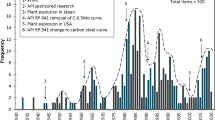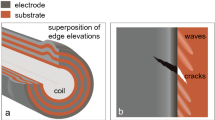Abstract
Battery explosion incidents hinder the development and application of Li-ion batteries. This paper describes the use of nondestructive computed tomography (CT) to analyze cylindrical Li-ion battery samples that underwent thermal runaway and exploded. Unlike destructive analysis methods, which can lead to a loss of battery structural information, CT scan allows direct observation of a battery’s internal structure without disassembly. In this study, two case studies of 20700 and 18650 batteries show that sidewall and bottom case rupture was caused by blockage of the battery vent region, which prevented the release of the generated gas. This work demonstrates the ability of CT for post-mortem incident analysis and the limitations of current vent design, and also gives insight to a safety issue with some cylindrical batteries.









Similar content being viewed by others
References
Ditch B (2018) The impact of thermal runaway on sprinkler protection recommendations for warehouse storage of cartoned lithium-ion batteries. Fire Technol 54:359–377. https://doi.org/10.1007/s10694-017-0687-6
Wang Q, Shao G, Duan Q, Chen M, Li Y, Wu K, Liu B, Peng P, Sun J (2016) The efficiency of heptafluoropropane fire extinguishing agent on suppressing the lithium titanate battery fire. Fire Technol 52:387–396. https://doi.org/10.1007/s10694-015-0531-9
Chen M, He Y, De Zhou C, Richard Y, Wang J (2016) Experimental study on the combustion characteristics of primary lithium batteries fire. Fire Technol 52:365–385. https://doi.org/10.1007/s10694-014-0450-1
Yenduri A, Sumant O (2018) Lithium ion battery market by component (cathode, anode, electrolytic solution, and others) and end-use industry (electrical & electronics, automotive, and industrial): global opportunity analysis and industry forecast, 2018 - 2025. https://www.alliedmarketresearch.com/lithium-ion-battery-market. Accessed 8 Nov 2019
FAA Office of Security and Hazardous Materials Safety (2019) Events with smoke, fire, extreme heat or explosion involving lithium batteries. https://www.faa.gov/hazmat/resources/lithium_batteries/media/Battery_incident_chart.pdf. Accessed 8 Nov 2019
Zhong G, Li H, Wang C, Xu K, Wang Q (2018) Experimental analysis of thermal runaway propagation risk within 18650 lithium-ion battery modules. J Electrochem Soc 165:A1925–A1934. https://doi.org/10.1149/2.0461809jes
Huang P, Ping P, Li K, Chen H, Wang Q, Wen J, Sun J (2016) Experimental and modeling analysis of thermal runaway propagation over the large format energy storage battery module with Li4Ti5O12 anode. Appl Energy 183:659–673. https://doi.org/10.1016/j.apenergy.2016.08.160
Ouyang D, Liu J, Chen M, Weng J, Wang J (2018) Thermal failure propagation in lithium-ion battery modules with various shapes. Appl Sci 8. https://doi.org/10.3390/app8081263
Said AO, Lee C, Stoliarov SI, Marshall AW (2019) Comprehensive analysis of dynamics and hazards associated with cascading failure in 18650 lithium ion cell arrays. Appl Energy 248:415–428. https://doi.org/10.1016/j.apenergy.2019.04.141
Said AO, Lee C, Stoliarov SI (2020) Experimental investigation of cascading failure in 18650 lithium ion cell arrays: Impact of cathode chemistry. J Power Sources 446:227347. https://doi.org/10.1016/j.jpowsour.2019.227347
Balakrishnan PG, Ramesh R, Prem Kumar T (2006) Safety mechanisms in lithium-ion batteries. J Power Sources 155:401–414. https://doi.org/10.1016/j.jpowsour.2005.12.002
Lyon RE, Walters RN (2016) Energetics of lithium ion battery failure. J Hazard Mater 318:164–172. https://doi.org/10.1016/j.jhazmat.2016.06.047
Spotnitz R, Franklin J (2003) Abuse behavior of high-power, lithium-ion cells. J Power Sources 113:81–100. https://doi.org/10.1016/S0378-7753(02)00488-3
Wu T, Chen H, Wang Q, Sun J (2018) Comparison analysis on the thermal runaway of lithium-ion battery under two heating modes. J Hazard Mater 344:733–741. https://doi.org/10.1016/j.jhazmat.2017.11.022
Wang Q, Ping P, Zhao X, Chu G, Sun J, Chen C (2012) Thermal runaway caused fire and explosion of lithium ion battery. J Power Sources 208:210–224. https://doi.org/10.1016/j.jpowsour.2012.02.038
Jhu CY, Wang YW, Wen CY, Chiang CC, Shu CM (2011) Self-reactive rating of thermal runaway hazards on 18650 lithium-ion batteries. J Therm Anal Calorim 106:159–163. https://doi.org/10.1007/s10973-011-1452-6
Kong L, Li C, Jiang J, Pecht MG (2018) Li-ion battery fire hazards and safety strategies. Energies 11:1–11. https://doi.org/10.3390/en11092191
Rosenberg E (2018) Exploding vape pen caused Florida man’s death, autopsy says. In: Washington Post. https://www.washingtonpost.com/news/to-your-health/wp/2018/05/16/man-died-after-a-vape-pen-exploded-and-embedded-pieces-into-this-head-autopsy-says/. Accessed 8 Nov 2019
Finegan DP, Darcy E, Keyser M, Tjaden B, Heenan TMM, Jervis R, Bailey JJ, Vo NT, Magdysyuk O V., Drakopoulos M, Michiel M Di, Rack A, Hinds G, Brett DJL, Shearing PR (2018) Identifying the cause of rupture of Li-ion batteries during thermal runaway. Adv Sci 5. https://doi.org/10.1002/advs.201700369
Carter R, Huhman B, Love CT, Zenyuk I V. (2018) X-ray computed tomography comparison of individual and parallel assembled commercial lithium iron phosphate batteries at end of life after high rate cycling. J Power Sources 381:46–55. https://doi.org/10.1016/j.jpowsour.2018.01.087
Finegan DP, Scheel M, Robinson JB, Tjaden B, Di Michiel M, Hinds G, Brett DJL, Shearing PR (2016) Investigating lithium-ion battery materials during overcharge-induced thermal runaway: An operando and multi-scale X-ray CT study. Phys Chem Chem Phys 18:30912–30919. https://doi.org/10.1039/c6cp04251a
Finegan DP, Scheel M, Robinson JB, Tjaden B, Hunt I, Mason TJ, Millichamp J, Di Michiel M, Offer GJ, Hinds G, Brett DJL, Shearing PR (2015) In-operando high-speed tomography of lithium-ion batteries during thermal runaway. Nat Commun 6:1–10. https://doi.org/10.1038/ncomms7924
Wu Y, Saxena S, Xing Y, Wang Y, Li C, Yung WKC, Pecht M (2018) Analysis of manufacturing-induced defects and structural deformations in lithium-ion batteries using computed tomography. Energies 11. https://doi.org/10.3390/en11040925
Acknowledgments
The authors would like to thank the Center for Advanced Life Cycle Engineering (CALCE) at the University of Maryland, which is funded by more than 150 companies and organizations concerned with electronics reliability and safety. CALCE is a recipient of the NSF Innovation Award for its research into electronics reliability. The CALCE battery team explores battery design, test methods, life cycle reliability, and safety (See https://calce.umd.edu/batteries).
Author information
Authors and Affiliations
Corresponding author
Additional information
Publisher's Note
Springer Nature remains neutral with regard to jurisdictional claims in published maps and institutional affiliations.
Rights and permissions
About this article
Cite this article
Kong, L., Hu, X., Gui, G. et al. Computed Tomography Analysis of Li-Ion Battery Case Ruptures. Fire Technol 56, 2565–2578 (2020). https://doi.org/10.1007/s10694-020-00996-w
Received:
Accepted:
Published:
Issue Date:
DOI: https://doi.org/10.1007/s10694-020-00996-w




